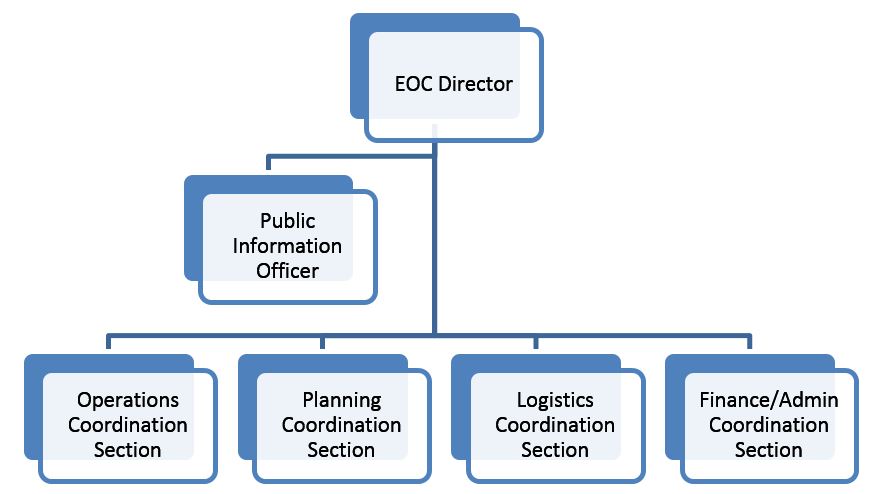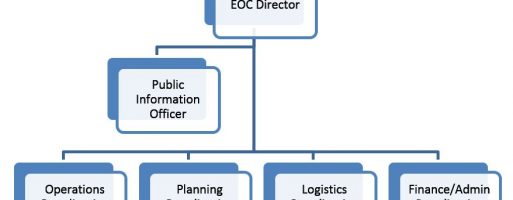In the National Incident Management System (NIMS) guidance released in October 2017, FEMA offers suggestions on how to adopt ICS-like structures to support Emergency Operations Centers (EOC). EOCs are used in varying ways at all levels of government (City, County, Region and/or State) and within private industry to provide coordination, support, direction, and control during emergencies. It is important to note that EOCs are not typically used for command and control of incident management but to support, coordinate, and provide direction for incidents (particularly in light of EOC oversight by elected officials such as governors, mayors, city managers, etc.).
Contrary to popular belief, there is no requirement for EOCs to implement and organize around ICS. EOCs support incident management at the Incident Command Post (on-scene or field level activities) and may be organized by:
• Major discipline (e.g., fire, law enforcement, or emergency medical services);
• Emergency support function (e.g., transportation, communications, public works and engineering, or resource support);
• Jurisdiction (e.g., city, county, or region); or,
• More likely, by some combination thereof.
While EOCs are not technically part of an Incident Command Structure, each organization decides when and how an organization would use their EOC. Many agencies and organizations leverage ICS in their EOCs, as it provides a framework to establish their own policies and procedures based upon a tried and true system. Given that many responders are already familiar with ICS, its use adopts a common language and creates alignment with what they are used to seeing in the field. This familiarity crosses over to the roles and responsibilities of specific positions in the EOC and its support, e.g., Public Information Officer. Use of the ICS can also address any duplicity between the EOC and the response and help reduce the effort required to support two systems.
While it is possible to use a standard ICS format to run an EOC, modifying ICS can allow EOC leaders to accommodate slight differences between ICS and an EOC. Modifications, such as title changes to better reflect the support nature of an EOC’s role, can help reinforce the concept that an EOC is not tactical; it is a coordination and support center. Often, EOCs achieve this by retitling the sections, adding “support” or “coordination” to the title (see below). It is important to note that the EOC roles and responsibilities should be clearly defined in an organization’s policies prior to an incident to reduce confusion between the EOC and any Incident Command Post (ICP) upon activation.
 EOC leaders often adjust ICS resource management processes to fit an EOC environment better. For example:
EOC leaders often adjust ICS resource management processes to fit an EOC environment better. For example:
• The various departments and agencies represented in the Operations Coordination Section may have access to internal departmental resources that they can order without going through the Logistics Coordination Section.
• The Logistics Coordination Section may have expertise in advanced resource ordering, such as (1) through mutual aid, (2) by leasing or purchasing, or (3) through a request for assistance from a governmental organization (e.g., state or Federal support).
• The personnel in the Operations Coordination Section may be better positioned to track incident resources than personnel in the Planning Coordination Section.
Although the staff in each EOC establishes protocols on how to coordinate and track the resource ordering functions at the EOC and with field personnel, EOC managers should look for opportunities to establish best practices into policy instead of reinventing the wheel each incident. In addition, it’s important to remember that the EOC is a coordination and support element, so it should facilitate ordering of requested personnel/resources/equipment from the Incident Commander/Unified Command and not order items based upon the EOC’s perceptions.
Regardless of format, an EOC should be organized to facilitate effective incident coordination and support in accordance with applicable laws, policies, ordinances, statutes, etc., that govern incident management and coordination in the jurisdiction the EOC serves. It is this non-standard approach that makes it difficult to develop standard EOC training. For this reason, EMSI’s seasoned cadre stands ready to help tailor EOC training to the unique needs and organization of your specific EOC. Our experience has found that this training is best conducted in a facilitated workshop format.
EMSI offers several workshops and courses that can be tailored to help EOCs prepare for their incident planning and management:
• Emergency Operations Center Management and Operations (FEMA/EMI IS-775/G775)
• Incident Management Team-Emergency Operations Center Interface (FEMA G191)
Since inception in 2000, EMSI has played a major role in helping government and industry clients alike, prepare, train, and respond to emergencies of any cause or size. Comprised of national and international all-risk, all-hazard response experts, EMSI’s seasoned cadre gives us a unique background and perspective in dealing with incident and responder needs at every level of government and industry, to include the international community. As a global response leader in all-risk, all-hazard, multi-discipline incidents, EMSI has a proven track record in helping the myriad of local, state, national, international, and private sector entities with their incident management and emergency management programs. EMSI is a service-disabled veteran owned minority business enterprise (MBE) that supports a broad range of clients. To learn more about EMSI and how we can help your organization’s response preparedness, please visit www.emsics.com.


